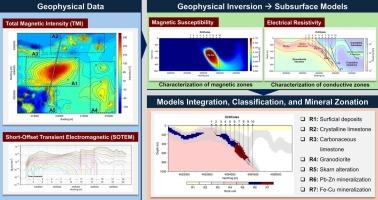祁曼塔格成矿带夕卡岩多金属成矿特征的磁与瞬变电磁反演
IF 3.6
2区 地球科学
Q1 GEOLOGY
引用次数: 0
摘要
中国对矿产资源日益增长的需求凸显了先进勘探技术的重要性。本研究对多金属资源丰富的Qimantagh成矿带(QMB)内的Yemaquan地区进行了调查,采用综合方法,结合总磁感应强度(TMI)和接地线短偏移瞬变电磁(SOTEM)数据,以识别潜在的夕卡岩型成矿。磁数据的三维反演显示,在25至350米的深度范围内,具有不同磁化率(0.01-0.18SI)的不同地下带,表明潜在的富铁聚集。SOTEM数据的准二维反演,集中在一个具有磁性的有利位置,揭示了一个导电带(~ 10 Ωm),表明矽卡岩蚀变沿着花岗闪长岩体和碳酸盐岩之间的接触。逆磁模型和瞬变电磁法模型的整合有助于将地下划分为7个不同的地质和成矿单元。值得注意的是,解释的矽卡岩带(R5)在空间上与50 ~ 150 m深度的Pb-Zn (R6)和350 m深度的Fe-Cu (R7)两种成矿风格相关。这些发现得到了该地区采矿钻孔的支持。研究结果表明,磁地球物理与电磁地球物理相结合的方法在复杂地质地形下进行定向找矿的有效性,为QMB资源评价与开发提供了重要信息。本文章由计算机程序翻译,如有差异,请以英文原文为准。

Inversion of magnetic and transient electromagnetic data for the characterization of skarn polymetallic mineralization in the Qimantagh Metallogenic Belt, China
The growing demand for mineral resources in China underscores the critical importance of advanced exploration techniques. This study investigates the Yemaquan area within the polymetallic resource-rich Qimantagh Metallogenic Belt (QMB), using an integrated approach that combines total magnetic intensity (TMI) and grounded-wire short-offset transient electromagnetic (SOTEM) data to identify potential skarn-hosted mineralization. A 3D inversion of magnetic data revealed distinct subsurface zones with varying magnetic susceptibilities (0.01–0.18SI) at depths ranging from 25 to 350 m, indicating potential iron-rich accumulations. A quasi-2D inversion of SOTEM data, focused on a magnetically promising location, revealed a conductive zone (∼10 Ωm), indicating skarn alteration along the contact between a granodiorite intrusion and carbonate rocks. The integration of the inverted magnetic and SOTEM models facilitated the classification of the subsurface into seven distinct geological and mineralization units. Notably, the interpreted skarn zone (R5) was spatially related to two mineralization styles: Pb–Zn (R6) at depths of 50–150 m and Fe–Cu (R7) at a depth of 350 m. These findings were supported by mining drillholes in the area. This study demonstrates the efficacy of combining magnetic and electromagnetic geophysical methods for targeted mineral exploration in complex geological terrains, providing critical information for resource assessment and development in the QMB.
求助全文
通过发布文献求助,成功后即可免费获取论文全文。
去求助
来源期刊

Ore Geology Reviews
地学-地质学
CiteScore
6.50
自引率
27.30%
发文量
546
审稿时长
22.9 weeks
期刊介绍:
Ore Geology Reviews aims to familiarize all earth scientists with recent advances in a number of interconnected disciplines related to the study of, and search for, ore deposits. The reviews range from brief to longer contributions, but the journal preferentially publishes manuscripts that fill the niche between the commonly shorter journal articles and the comprehensive book coverages, and thus has a special appeal to many authors and readers.
 求助内容:
求助内容: 应助结果提醒方式:
应助结果提醒方式:


